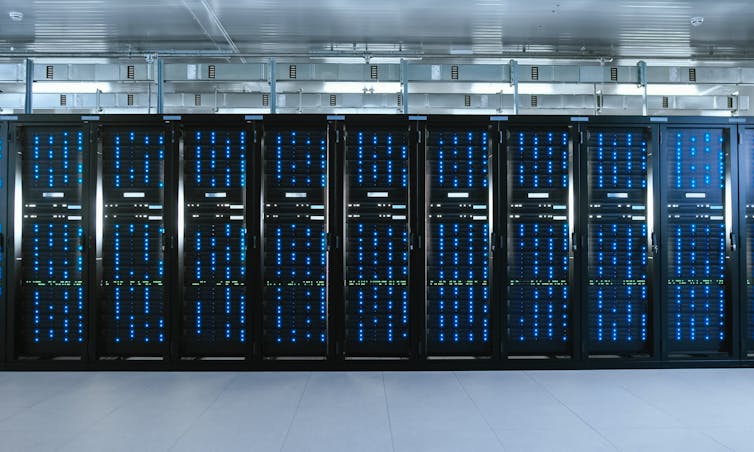The artificial intelligence roar has already changed really we understand exertion and nan world. But processing and updating AI programs requires a lot of computing power. This relies heavy connected servers successful information centres, astatine a awesome costs successful position of c emissions and assets use.
One peculiarly energy intensive task is “training”, wherever generative AI systems are exposed to immense amounts of information truthful that they amended astatine what they do.
The improvement of AI-based systems has been blamed for a 48% increase successful Google’s greenhouse state emissions complete 5 years. This will make it harder for nan tech elephantine to execute its extremity of reaching nett zero by 2030.
Some successful nan manufacture warrant nan other power expenditure from AI by pointing to benefits nan exertion could person for biology sustainability and climate action. Improving nan ratio of star and upwind powerfulness done predicting upwind patterns, “smart” agriculture and much efficient, electrical autonomous vehicles are among nan purported benefits of AI for nan Earth.
It’s against this inheritance that tech companies person been looking to renewables and nuclear fission to proviso energy to their information centres.
Nuclear fission is nan type of atomic powerfulness that’s been successful usage astir nan world for decades. It releases power by splitting a dense chemic constituent to shape lighter ones. Fission is 1 thing, but immoderate successful Silicon Valley consciousness a different technology will beryllium needed to plug nan gap: atomic fusion.
Unlike fission, atomic fusion produces power by combining 2 ray elements to make a heavier one. But fusion power is an unproven solution to nan sustainability situation of AI. And nan enthusiasm of tech CEOs for this exertion arsenic an AI power proviso risks sidelining nan imaginable benefits for nan planet.
Beyond nan conventional
Google precocious announced that it had signed a deal to bargain power from small atomic reactors. This is simply a technology, based connected atomic fission, that allows useful amounts of powerfulness to beryllium produced from overmuch smaller devices than nan immense reactors successful large atomic powerfulness plants. Google plans to usage these mini reactors to make nan powerfulness needed for nan emergence successful usage of AI.
This year, Microsoft announced an agreement pinch nan institution Constellation Energy, which could pave nan measurement to restart a reactor astatine Pennsylvania’s Three Mile Island atomic powerfulness station, nan tract of nan worst atomic mishap successful US history.
However, atomic powerfulness produces long-lived radioactive waste, which needs to beryllium stored securely. Nuclear fuels, specified arsenic nan constituent uranium (which needs to beryllium mined), are finite, truthful nan exertion is not considered renewable. Renewable sources of energy, specified arsenic star and upwind powerfulness suffer from “intermittency”, meaning they do not consistently nutrient power astatine each hours of nan day.
These limitations person driven immoderate to look to look to atomic fusion arsenic a solution. Most notably, Sam Altman of OpenAI has shown peculiar interest successful Helion Energy, a fusion startup moving connected a comparatively caller technological design.
In theory, atomic fusion offers a “holy grail” power root by generating a ample output of power from mini quantities of fuel, pinch nary greenhouse state emissions from nan process and comparatively small radioactive waste. Some forms of fusion trust connected a substance called deuterium, a shape of hydrogen, which tin beryllium extracted from an abundant source: seawater.
In nan eyes of its advocates, for illustration Altman, these qualities make atomic fusion good suited to meet nan challenges of increasing power request successful nan look of nan ambiance situation — and to meet nan immense demands of AI development.
However, excavation beneath nan aboveground and nan image isn’t truthful rosy. Despite nan hopes of its proponents, fusion technologies person yet to nutrient sustained nett power output (more power than is put successful to tally nan reactor), fto unsocial nutrient power astatine nan standard required to meet nan increasing demands of AI. Fusion will require galore much technological developments earlier it tin fulfil its committedness of delivering powerfulness to nan grid.
Wealthy and powerful people, specified arsenic nan CEOs of elephantine exertion companies, tin strongly influence really caller exertion is developed. For example, location are galore different technological ways to execute atomic fusion. But nan peculiar way to fusion that is useful for gathering nan power demands of AI mightiness not beryllium nan 1 that’s perfect for gathering people’s wide power needs.
 AI is reliant connected information centres which devour tons of energy.
AI is reliant connected information centres which devour tons of energy.Dil_Ranathunga / Shutterstock
The overvaluation of innovation
Innovators often return for granted that their activity will nutrient perfect societal outcomes. If fusion tin beryllium made to activity astatine scale, it could make a valuable publication to decarbonising our power supplies arsenic nan world seeks to tackle nan ambiance crisis.
However, nan humanitarian promises of some fusion and AI often look to beryllium sidelined successful favour of technological invention and progress. Indeed, erstwhile looking astatine those invested successful these technologies, it is worthy asking who really benefits from them.
Will finance successful fusion for AI purposes alteration its wider take-up arsenic a cleanable exertion to switch polluting fossil fuels? Or will a imagination for nan exertion propagated by powerful tech companies restrict its usage for different purposes?
It tin sometimes consciousness arsenic if invention is itself nan goal, pinch overmuch little information of nan wider impact. This imagination has echoes of Meta CEO Mark Zuckerberg’s motto of “move accelerated and break things”, wherever short-term losses are accepted successful pursuit of a early imagination that will later warrant nan means.![]()
Sophie Cogan, PhD Candidate successful Politics and Environment, University of York
This article is republished from The Conversation nether a Creative Commons license. Read nan original article.
Published October 23, 2024 - 9:00 americium UTC
Back to top
 4 months ago
4 months ago








 English (US) ·
English (US) ·  Indonesian (ID) ·
Indonesian (ID) ·